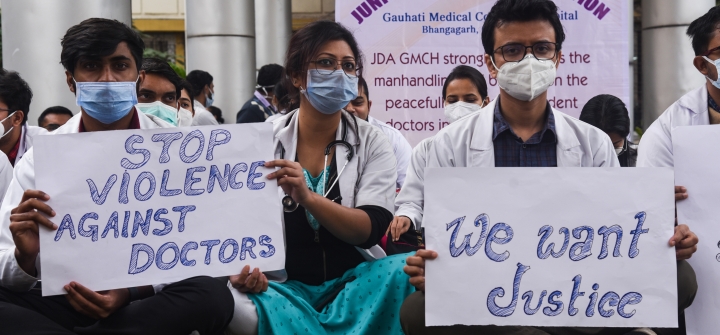
Context
Recently it has been observed that violence against healthcare workers is a disturbingly common occurrence in India.
About
- Statistics reveal a sample of increasing aggression, especially in public healthcare facilities.
- These incidents spotlight the harsh reality that violence is more common in public health facilities and disproportionately impacts more young and female professionals.
What type of Violence is confronted by Healthcare Professionals?
- According to a 2016 report in the National Medical Journal of India, 75% of the violence against medical doctors is verbal, such as intimidation and threats.
- Workplace violence is mainly directed at junior docs and residents.
- Studies also show that female medical experts, with lesser years of experience, are objectively more at risk of being on the risk of both physical and verbal workplace violence.
- The violence also takes place more regularly in high-stake settings, including in the emergency wing and intensive care units.
What are the Reasons for the Violence?
- The perpetrators of violence are family members or relatives of the patient in 82.2% of instances, as per a report published in PLoS ONE in 2020.
- Often, patients or their relatives turn to violence since the healthcare system hasn’t met their expectations.
- Some perpetrators turn out to be violent over concerns of the affected person’s condition, such as actual or perceived deterioration of their condition or doubts about the wrong treatment being administered.
- Some others grow to be violent due to issues which include high cost dues and chronic waiting times. Doctors aren’t responsible for either.
Impact of Violence
- Psychological Impact: Being at the risk of verbal or physical violence has a severe psychological effect.
- Some research has stated symptoms of post-traumatic stress disorder, tension, and despair in docs who’ve faced violence from patients or their relatives.
- Effect Rural Healthcare: India has a skewed medical doctor-patient ratio, doctors often determine to perform in resource-abundant settings for their own security. This in turn impacts rural healthcare.
- Effect of Quality of Healthcare: After experiencing violence, doctors want to stop presenting emergency services, refer sufferers faster to more specialists, and over-look at signs and symptoms and prescribe more exams.
Present Scenario of Legal Protection to Healthcare Professionals
- No such law existed to protect healthcare professionals nationally.
- As of 2020, 19 States had implemented their statutes, every with varying provisions. Other States and Union Territories had no laws in any respect.
- This loss of uniformity meant safety is inconsistent.
- Among States, Kerala and Karnataka now offer their healthcare employees with the most strong legal protections in India.
- Challenges in enacting a Central law: A important law has now not been enacted since public health is a State subject, and VAHCW is more often than not a public health-related issue.
- While the concurrent listing allows for a relevant law, the imperative government has not prioritised this difficulty, leaving it to the States to manage.
Way Ahead
- Strengthen the System: To eliminate this ‘risk’, we ought to spend more money to reinforce the system from the grassroots level, including lowering long waiting intervals for treatment.
- The availability and accessibility of drugs, tests, and financial resources for the ones in want will greatly reduce their strain, as opposed to leaving them to keep their physicians answerable for it.
- Policy and Institutional Measures: Installing CCTV cameras and steel detectors at hospital entrances to discourage relatives from carrying weapons are practicable, however they may be currently easier to realise in private settings and now not at public facilities.
- Ensuring that there are counselors to help sufferers and family in instances of high emotional misery can eliminate any miscommunication concerning an affected person’s condition and treatment.
- In addition, a robust safety system and no longer allowing various relatives by a patient’s bedside may also be important.
- After the West Bengal incident, the Central Government has declared that it’s going to form a high-stage committee to check the 2019 invoice tabled in parliament for making the Central Act for protection of healthcare workers.
- Until a significant regulation turns into a fact, those State-level reforms constitute a giant breakthrough in safeguarding individuals who devote their lives to worrying for others.
Source: News on AIR
Post Views: 522
